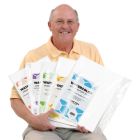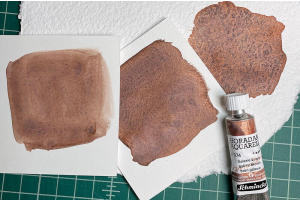We use cookies to make your experience better. To comply with the new e-Privacy directive, we need to ask for your consent to set the cookies. Learn more.
Cheap Joe’s Art Stuff Art Blog
Tips, Tricks, Thoughts, and inspiration from across the art spectrum.
Blocks, Sheets and Elephants, Oh My!


Weight


Texture
Watercolor paper comes in various textures which are called “presses”. This refers to the way the paper is prepared after it is taken from the mold. There is hot press, cold press, rough and also soft press. (the images shown here are from the Arches paper mill) The hot press paper is passed between two heated rollers which iron out all of the texture and creates a very smooth surface. This is desired when you have a lot of fine detail in your painting and also when using pen and ink. The cold press paper is passed between rollers with no heat. It is also called “Not”, which refers to being “not hot pressed”. It is a medium texture that is appropriate for most watercolor techniques. This is probably the most versatile and popular of all the textures. Rough press is actually not pressed at all. It retains all the texture that is produced when the paper is removed from the mold. This is a great texture to use for landscapes as you do not have to simulate the natural textures of trees and rocks. Rough watercolor paper is not as popular as the other presses. The last and least known texture is soft press. It is in between hot and cold press and has a velvety texture. This is a nice change from the cold press when you still need some light “tooth” to the paper.Color
You also have a choice in color. Watercolor paper comes in two basic colors of white. Bright white, which is compared to copy paper white, is a great choice when painting with bright colors such as with florals. Also, natural white, which is an off white and works especially well for landscapes and portraits.Format
You can now choose which weight, texture and color, but what about what form to buy? There are sheets, pads and even blocks available. You know about full sheets and probably have used pads of paper in the past. Blocks, however, are not as well known. A block is a stack of watercolor paper that is glued on all four sides. It has a small space usually at the top that is not glued which allows you to separate the pages. The advantage of a block is that it is pre-stretched, meaning it will not allow the paper to wrinkle or buckle when a large amount of water is used. After the painting is complete, allow it to dry thoroughly, usually overnight. Then remove the painting from the block by inserting a palette knife between the first and second sheets and pull it around the edges and back to the top, releasing the top sheet. Blocks are available in many standard sizes including 9" x 12", 12" x 16", 18" x 24" and also a 4" x 6" postcard size, which is great for travel. Paint a picture, write a note on the back (Wish you were here!) , stamp and drop in the mailbox! Instant greetings! Blocks come in 140 lb., cold press, hot press and rough and also the 300 lb., usually in cold press only. They are convenient to use because you do not have to mount your paper to a painting board. This can save time and space especially if you are painting plein air! The only disadvantage over sheet paper is that you can only work on one painting at a time. This does not seem to be an issue as blocks are very popular!Wow, who would have guessed there would be so much information about the watercolor paper to consider! This is just basic information to get you started. It is really up to you to find which one works for you and with so many choices, it can be quite expensive to try them all. That is why Watercolor Paper Sample Packs are available at Cheap Joe's. They give you the opportunity to try several of our most popular brands and types of watercolor paper at a really great price. This is a great way to find your favorite! For beginners, the most common choice for watercolor paper would be a 140 lb. cold press paper in a natural white, probably in a block or pad. Cheap Joe's also has their own brand in Kilimanjaro Original Bright White Watercolor Paper, which also comes in natural white sheets, watercolor blocks, and watercolor pads. It is important to purchase the best quality paper that you can afford. This will make your watercolor experience more successful and enjoyable, which is the real reason you took up painting in the first place! Right?











